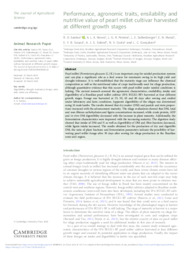Performance, agronomic traits, ensilability and nutritive value of pearl millet cultivar harvested at different growth stages.
Performance, agronomic traits, ensilability and nutritive value of pearl millet cultivar harvested at different growth stages.
Author(s): SANTOS, R. D. dos; NEVES, A. L. A.; PEREIRA, L. G. R.; SOLLENBERGER, L. E.; MUNIZ, E. N.; SOUZA, E. Y. B.; SOBRAL, A. J. S.; COSTA, N. V.; GONCALVES, L. C.
Summary: Pearl millet (Pennisetum glaucum (L.) R.) is an important crop for rainfed production systems and can play a significant role as a feed source for ruminants owing to its high yield and drought tolerance. It is well-established that the maturity stage can influence the chemical composition as well as the nutritional value of crops traditionally used for silage production, although quantitative evidence that this occurs with pearl millet under rainfed conditions is lacking. The current research assessed the agronomic characteristics, ensilability, intake and digestibility of a Brazilian pearl millet cultivar (IPA BULK1-BF) harvested at four different growth stages. Forage was harvested at 35, 50, 65 and 80 days after sowing and ensiled under laboratory and farm conditions. Apparent digestibility of the silages was determined using 24 male lambs. The results showed that dry matter (DM) and panicle and stem proportions increased with the advancement maturity. The silage evaluations showed that DM, total and non-fibrous carbohydrates and lignin concentrations increased, while crude protein, ADF and in vitro DM digestibility decreased with the increase in plant maturity. Additionally, the fermentation characteristics were improved with the increasing maturity. The digestion study showed that intake of DM and N as well as digestibility of DM and fibre fractions decreased, while lignin intake increased. The results obtained for the production of dry and digestible DM, the ratio of plant fractions and fermentation parameters indicate the possibility of harvesting pearl millet forage after 50 days after sowing for silage production in the Brazilian semi-arid region.
Publication year: 2020
Types of publication: Journal article
Unit: Embrapa Semi-arid Region
Observation
Some of Embrapa's publications are published as ePub files. To read them, use or download one of the following free software options to your computer or mobile device. Android: Google Play Books; IOS: iBooks; Windows and Linux: Calibre.
Access other publications
Access the Agricultural Research Database (BDPA) to consult Embrapa's full library collection and records.
Visit Embrapa Bookstore to purchase books and other publications sold by Embrapa.

